Comprehensive Report: Leadership, Operations, and Management at IKEA
VerifiedAdded on 2021/02/21
|15
|4551
|125
Report
AI Summary
This report provides a comprehensive analysis of leadership and operations management within IKEA. It begins by differentiating the roles of leaders and managers, highlighting their functions in various scenarios, such as low product awareness, lack of technological knowledge, and employee conflicts. The report delves into different leadership theories, including situational, system, and contingency leadership, explaining their application and implications within the company. It also explores key approaches to operations management and the roles that leaders and managers play in achieving business objectives. Furthermore, the report examines factors within the business environment that impact operational management and decision-making, offering a detailed understanding of IKEA's operational strategies and leadership dynamics.
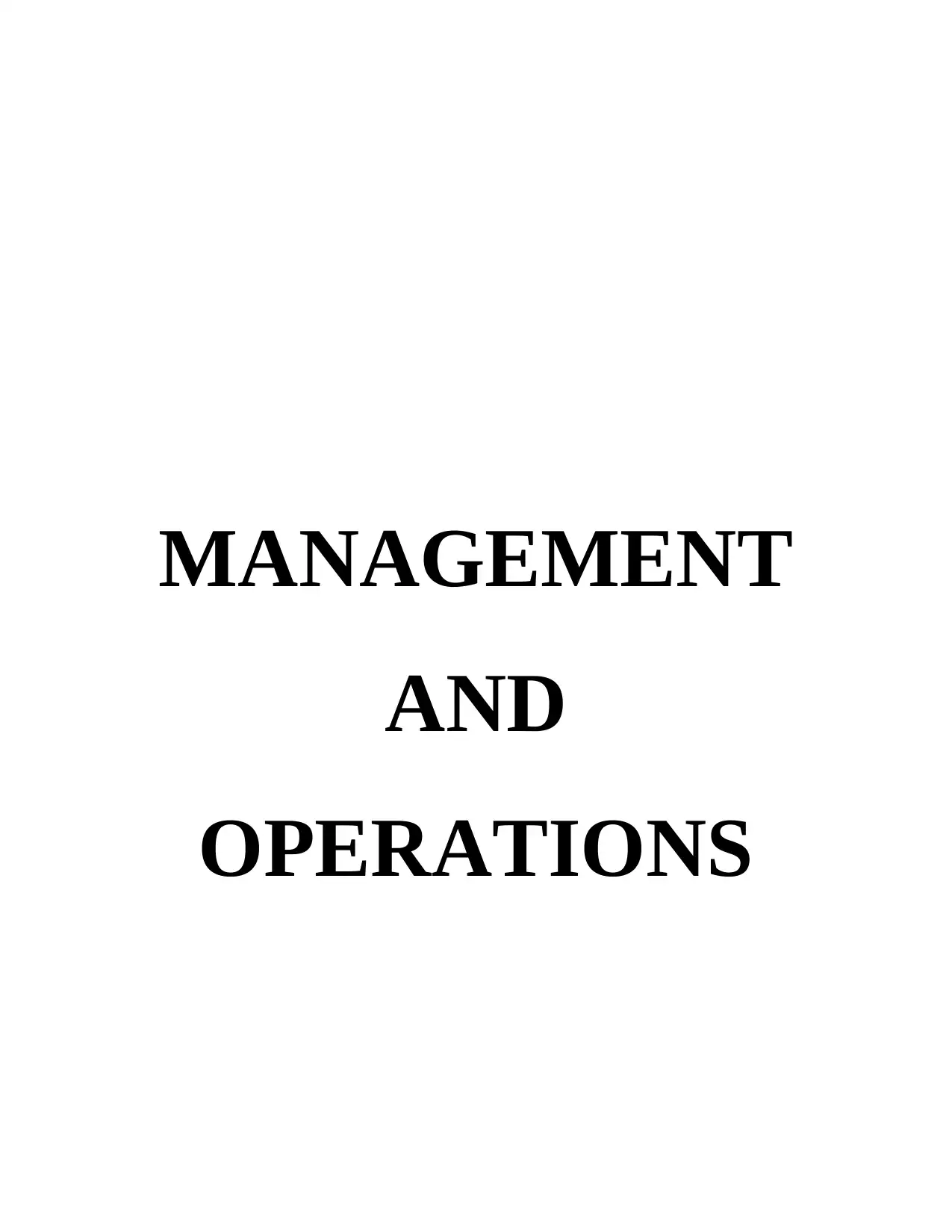
MANAGEMENT
AND
OPERATIONS
AND
OPERATIONS
Paraphrase This Document
Need a fresh take? Get an instant paraphrase of this document with our AI Paraphraser
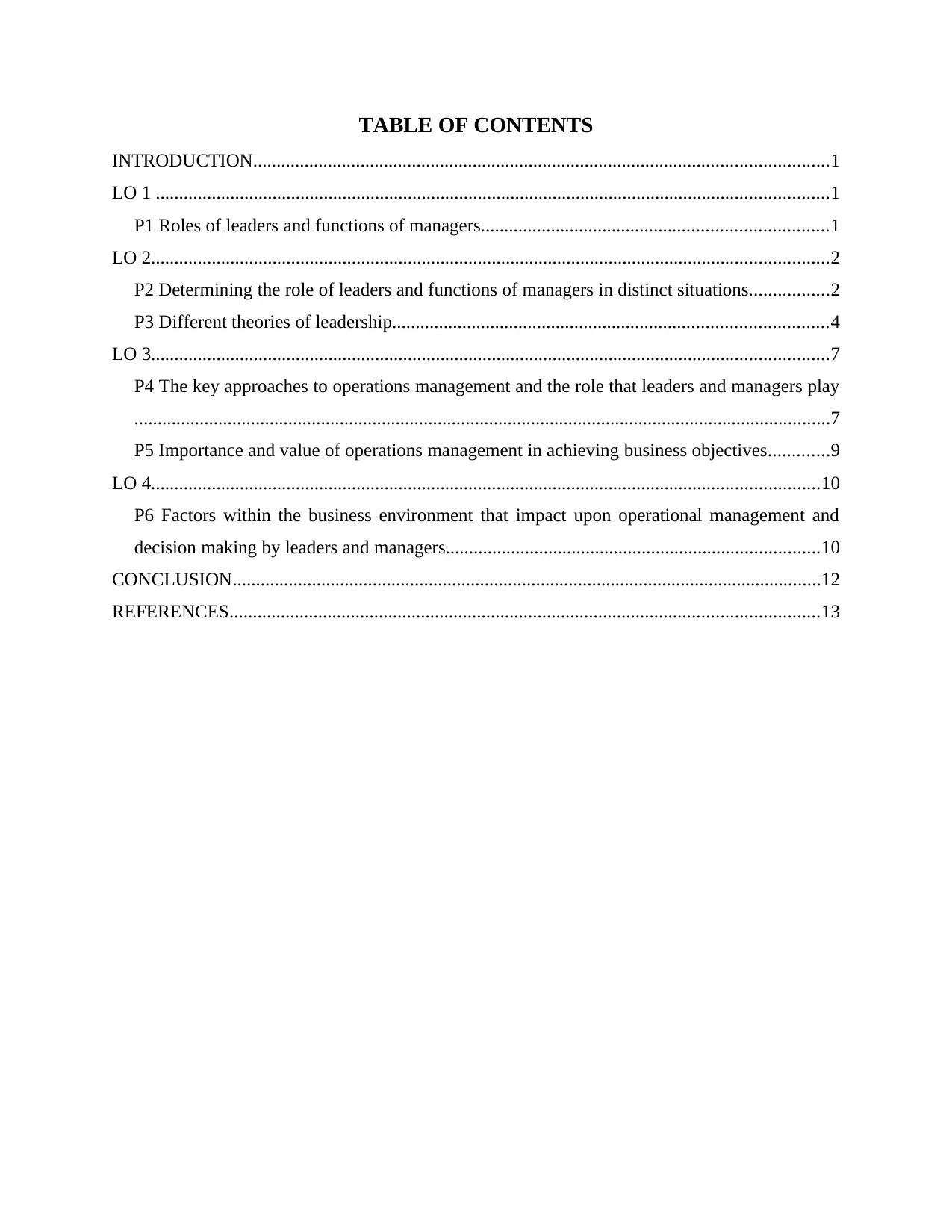
TABLE OF CONTENTS
INTRODUCTION...........................................................................................................................1
LO 1 ................................................................................................................................................1
P1 Roles of leaders and functions of managers..........................................................................1
LO 2.................................................................................................................................................2
P2 Determining the role of leaders and functions of managers in distinct situations.................2
P3 Different theories of leadership.............................................................................................4
LO 3.................................................................................................................................................7
P4 The key approaches to operations management and the role that leaders and managers play
.....................................................................................................................................................7
P5 Importance and value of operations management in achieving business objectives.............9
LO 4...............................................................................................................................................10
P6 Factors within the business environment that impact upon operational management and
decision making by leaders and managers................................................................................10
CONCLUSION..............................................................................................................................12
REFERENCES..............................................................................................................................13
INTRODUCTION...........................................................................................................................1
LO 1 ................................................................................................................................................1
P1 Roles of leaders and functions of managers..........................................................................1
LO 2.................................................................................................................................................2
P2 Determining the role of leaders and functions of managers in distinct situations.................2
P3 Different theories of leadership.............................................................................................4
LO 3.................................................................................................................................................7
P4 The key approaches to operations management and the role that leaders and managers play
.....................................................................................................................................................7
P5 Importance and value of operations management in achieving business objectives.............9
LO 4...............................................................................................................................................10
P6 Factors within the business environment that impact upon operational management and
decision making by leaders and managers................................................................................10
CONCLUSION..............................................................................................................................12
REFERENCES..............................................................................................................................13
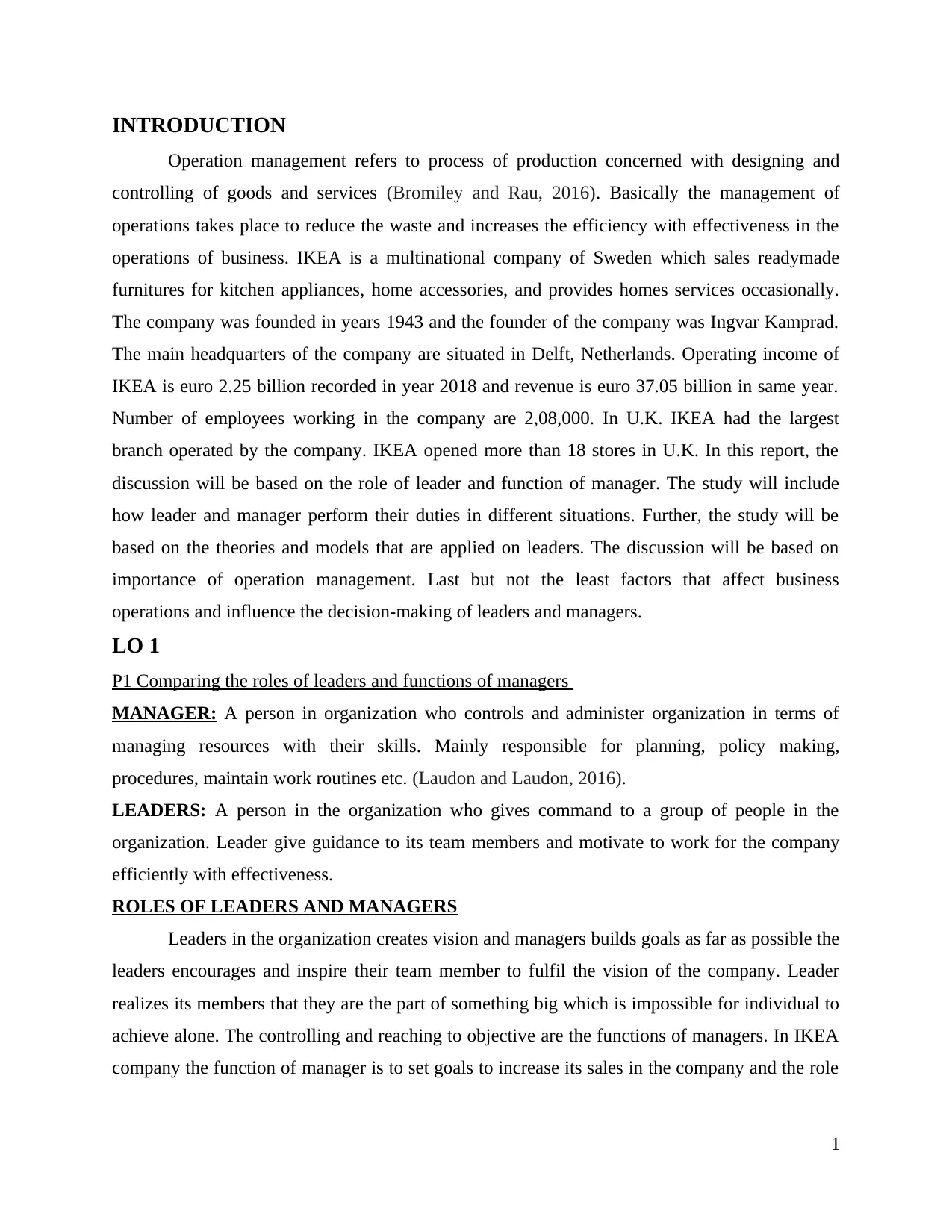
INTRODUCTION
Operation management refers to process of production concerned with designing and
controlling of goods and services (Bromiley and Rau, 2016). Basically the management of
operations takes place to reduce the waste and increases the efficiency with effectiveness in the
operations of business. IKEA is a multinational company of Sweden which sales readymade
furnitures for kitchen appliances, home accessories, and provides homes services occasionally.
The company was founded in years 1943 and the founder of the company was Ingvar Kamprad.
The main headquarters of the company are situated in Delft, Netherlands. Operating income of
IKEA is euro 2.25 billion recorded in year 2018 and revenue is euro 37.05 billion in same year.
Number of employees working in the company are 2,08,000. In U.K. IKEA had the largest
branch operated by the company. IKEA opened more than 18 stores in U.K. In this report, the
discussion will be based on the role of leader and function of manager. The study will include
how leader and manager perform their duties in different situations. Further, the study will be
based on the theories and models that are applied on leaders. The discussion will be based on
importance of operation management. Last but not the least factors that affect business
operations and influence the decision-making of leaders and managers.
LO 1
P1 Comparing the roles of leaders and functions of managers
MANAGER: A person in organization who controls and administer organization in terms of
managing resources with their skills. Mainly responsible for planning, policy making,
procedures, maintain work routines etc. (Laudon and Laudon, 2016).
LEADERS: A person in the organization who gives command to a group of people in the
organization. Leader give guidance to its team members and motivate to work for the company
efficiently with effectiveness.
ROLES OF LEADERS AND MANAGERS
Leaders in the organization creates vision and managers builds goals as far as possible the
leaders encourages and inspire their team member to fulfil the vision of the company. Leader
realizes its members that they are the part of something big which is impossible for individual to
achieve alone. The controlling and reaching to objective are the functions of managers. In IKEA
company the function of manager is to set goals to increase its sales in the company and the role
1
Operation management refers to process of production concerned with designing and
controlling of goods and services (Bromiley and Rau, 2016). Basically the management of
operations takes place to reduce the waste and increases the efficiency with effectiveness in the
operations of business. IKEA is a multinational company of Sweden which sales readymade
furnitures for kitchen appliances, home accessories, and provides homes services occasionally.
The company was founded in years 1943 and the founder of the company was Ingvar Kamprad.
The main headquarters of the company are situated in Delft, Netherlands. Operating income of
IKEA is euro 2.25 billion recorded in year 2018 and revenue is euro 37.05 billion in same year.
Number of employees working in the company are 2,08,000. In U.K. IKEA had the largest
branch operated by the company. IKEA opened more than 18 stores in U.K. In this report, the
discussion will be based on the role of leader and function of manager. The study will include
how leader and manager perform their duties in different situations. Further, the study will be
based on the theories and models that are applied on leaders. The discussion will be based on
importance of operation management. Last but not the least factors that affect business
operations and influence the decision-making of leaders and managers.
LO 1
P1 Comparing the roles of leaders and functions of managers
MANAGER: A person in organization who controls and administer organization in terms of
managing resources with their skills. Mainly responsible for planning, policy making,
procedures, maintain work routines etc. (Laudon and Laudon, 2016).
LEADERS: A person in the organization who gives command to a group of people in the
organization. Leader give guidance to its team members and motivate to work for the company
efficiently with effectiveness.
ROLES OF LEADERS AND MANAGERS
Leaders in the organization creates vision and managers builds goals as far as possible the
leaders encourages and inspire their team member to fulfil the vision of the company. Leader
realizes its members that they are the part of something big which is impossible for individual to
achieve alone. The controlling and reaching to objective are the functions of managers. In IKEA
company the function of manager is to set goals to increase its sales in the company and the role
1
You're viewing a preview
Unlock full access by subscribing today!
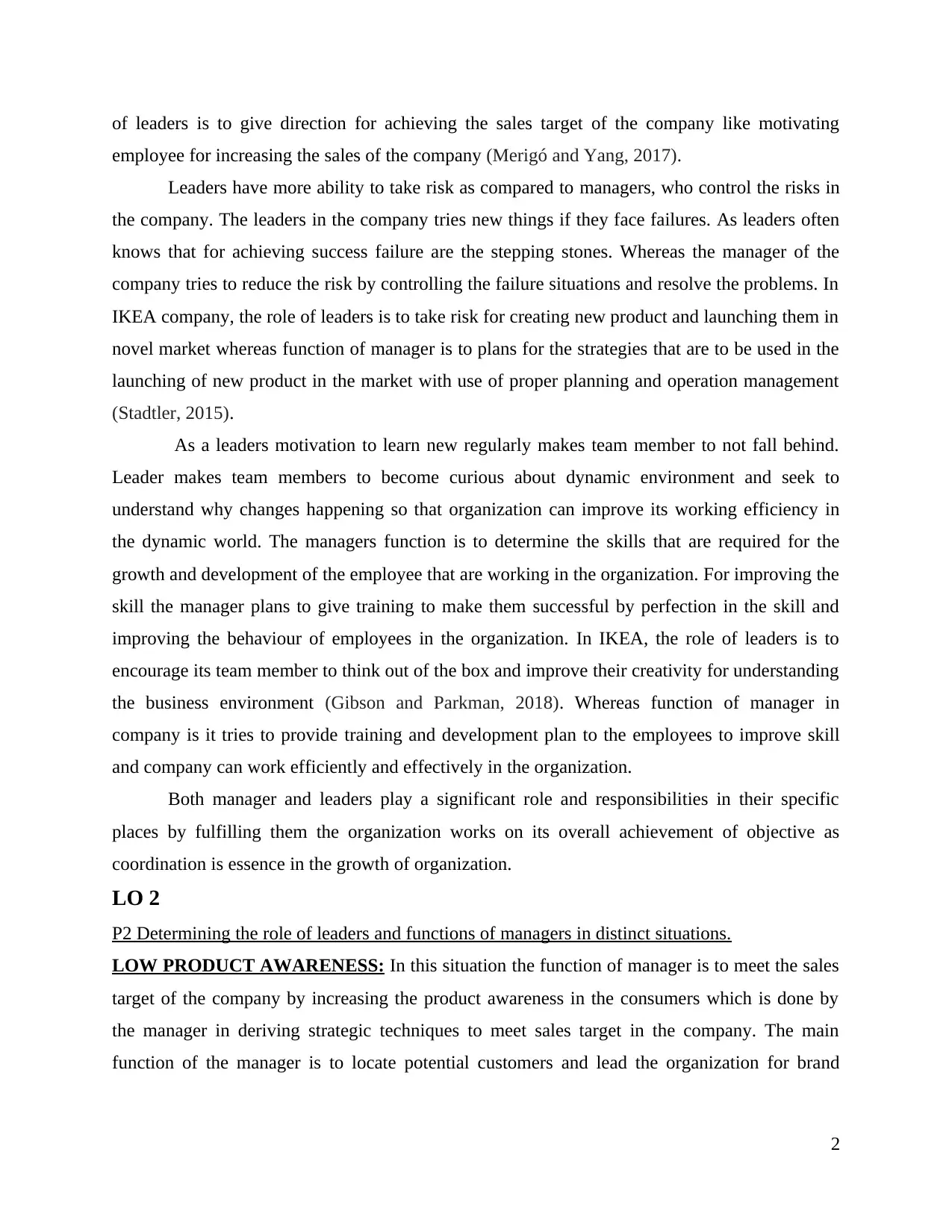
of leaders is to give direction for achieving the sales target of the company like motivating
employee for increasing the sales of the company (Merigó and Yang, 2017).
Leaders have more ability to take risk as compared to managers, who control the risks in
the company. The leaders in the company tries new things if they face failures. As leaders often
knows that for achieving success failure are the stepping stones. Whereas the manager of the
company tries to reduce the risk by controlling the failure situations and resolve the problems. In
IKEA company, the role of leaders is to take risk for creating new product and launching them in
novel market whereas function of manager is to plans for the strategies that are to be used in the
launching of new product in the market with use of proper planning and operation management
(Stadtler, 2015).
As a leaders motivation to learn new regularly makes team member to not fall behind.
Leader makes team members to become curious about dynamic environment and seek to
understand why changes happening so that organization can improve its working efficiency in
the dynamic world. The managers function is to determine the skills that are required for the
growth and development of the employee that are working in the organization. For improving the
skill the manager plans to give training to make them successful by perfection in the skill and
improving the behaviour of employees in the organization. In IKEA, the role of leaders is to
encourage its team member to think out of the box and improve their creativity for understanding
the business environment (Gibson and Parkman, 2018). Whereas function of manager in
company is it tries to provide training and development plan to the employees to improve skill
and company can work efficiently and effectively in the organization.
Both manager and leaders play a significant role and responsibilities in their specific
places by fulfilling them the organization works on its overall achievement of objective as
coordination is essence in the growth of organization.
LO 2
P2 Determining the role of leaders and functions of managers in distinct situations.
LOW PRODUCT AWARENESS: In this situation the function of manager is to meet the sales
target of the company by increasing the product awareness in the consumers which is done by
the manager in deriving strategic techniques to meet sales target in the company. The main
function of the manager is to locate potential customers and lead the organization for brand
2
employee for increasing the sales of the company (Merigó and Yang, 2017).
Leaders have more ability to take risk as compared to managers, who control the risks in
the company. The leaders in the company tries new things if they face failures. As leaders often
knows that for achieving success failure are the stepping stones. Whereas the manager of the
company tries to reduce the risk by controlling the failure situations and resolve the problems. In
IKEA company, the role of leaders is to take risk for creating new product and launching them in
novel market whereas function of manager is to plans for the strategies that are to be used in the
launching of new product in the market with use of proper planning and operation management
(Stadtler, 2015).
As a leaders motivation to learn new regularly makes team member to not fall behind.
Leader makes team members to become curious about dynamic environment and seek to
understand why changes happening so that organization can improve its working efficiency in
the dynamic world. The managers function is to determine the skills that are required for the
growth and development of the employee that are working in the organization. For improving the
skill the manager plans to give training to make them successful by perfection in the skill and
improving the behaviour of employees in the organization. In IKEA, the role of leaders is to
encourage its team member to think out of the box and improve their creativity for understanding
the business environment (Gibson and Parkman, 2018). Whereas function of manager in
company is it tries to provide training and development plan to the employees to improve skill
and company can work efficiently and effectively in the organization.
Both manager and leaders play a significant role and responsibilities in their specific
places by fulfilling them the organization works on its overall achievement of objective as
coordination is essence in the growth of organization.
LO 2
P2 Determining the role of leaders and functions of managers in distinct situations.
LOW PRODUCT AWARENESS: In this situation the function of manager is to meet the sales
target of the company by increasing the product awareness in the consumers which is done by
the manager in deriving strategic techniques to meet sales target in the company. The main
function of the manager is to locate potential customers and lead the organization for brand
2
Paraphrase This Document
Need a fresh take? Get an instant paraphrase of this document with our AI Paraphraser
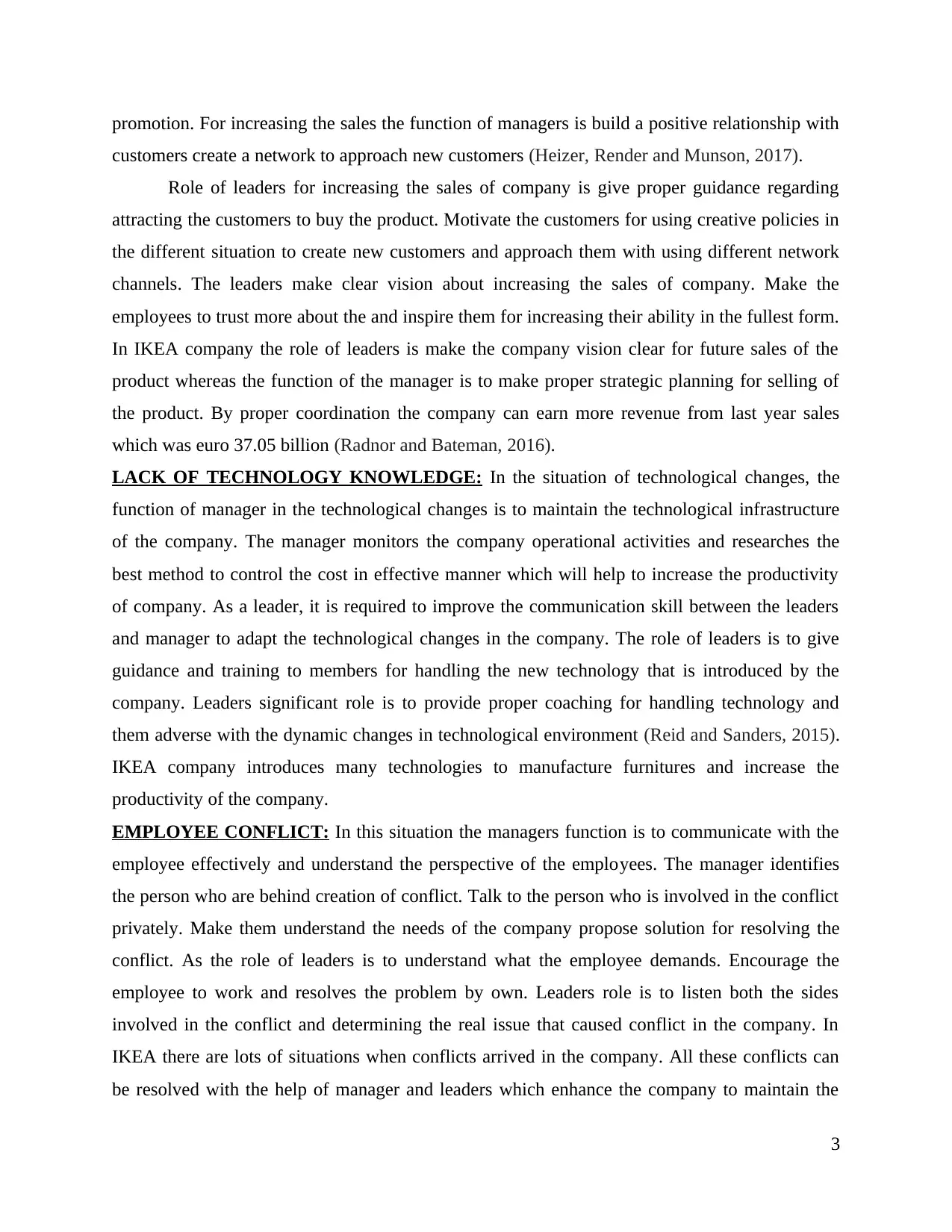
promotion. For increasing the sales the function of managers is build a positive relationship with
customers create a network to approach new customers (Heizer, Render and Munson, 2017).
Role of leaders for increasing the sales of company is give proper guidance regarding
attracting the customers to buy the product. Motivate the customers for using creative policies in
the different situation to create new customers and approach them with using different network
channels. The leaders make clear vision about increasing the sales of company. Make the
employees to trust more about the and inspire them for increasing their ability in the fullest form.
In IKEA company the role of leaders is make the company vision clear for future sales of the
product whereas the function of the manager is to make proper strategic planning for selling of
the product. By proper coordination the company can earn more revenue from last year sales
which was euro 37.05 billion (Radnor and Bateman, 2016).
LACK OF TECHNOLOGY KNOWLEDGE: In the situation of technological changes, the
function of manager in the technological changes is to maintain the technological infrastructure
of the company. The manager monitors the company operational activities and researches the
best method to control the cost in effective manner which will help to increase the productivity
of company. As a leader, it is required to improve the communication skill between the leaders
and manager to adapt the technological changes in the company. The role of leaders is to give
guidance and training to members for handling the new technology that is introduced by the
company. Leaders significant role is to provide proper coaching for handling technology and
them adverse with the dynamic changes in technological environment (Reid and Sanders, 2015).
IKEA company introduces many technologies to manufacture furnitures and increase the
productivity of the company.
EMPLOYEE CONFLICT: In this situation the managers function is to communicate with the
employee effectively and understand the perspective of the employees. The manager identifies
the person who are behind creation of conflict. Talk to the person who is involved in the conflict
privately. Make them understand the needs of the company propose solution for resolving the
conflict. As the role of leaders is to understand what the employee demands. Encourage the
employee to work and resolves the problem by own. Leaders role is to listen both the sides
involved in the conflict and determining the real issue that caused conflict in the company. In
IKEA there are lots of situations when conflicts arrived in the company. All these conflicts can
be resolved with the help of manager and leaders which enhance the company to maintain the
3
customers create a network to approach new customers (Heizer, Render and Munson, 2017).
Role of leaders for increasing the sales of company is give proper guidance regarding
attracting the customers to buy the product. Motivate the customers for using creative policies in
the different situation to create new customers and approach them with using different network
channels. The leaders make clear vision about increasing the sales of company. Make the
employees to trust more about the and inspire them for increasing their ability in the fullest form.
In IKEA company the role of leaders is make the company vision clear for future sales of the
product whereas the function of the manager is to make proper strategic planning for selling of
the product. By proper coordination the company can earn more revenue from last year sales
which was euro 37.05 billion (Radnor and Bateman, 2016).
LACK OF TECHNOLOGY KNOWLEDGE: In the situation of technological changes, the
function of manager in the technological changes is to maintain the technological infrastructure
of the company. The manager monitors the company operational activities and researches the
best method to control the cost in effective manner which will help to increase the productivity
of company. As a leader, it is required to improve the communication skill between the leaders
and manager to adapt the technological changes in the company. The role of leaders is to give
guidance and training to members for handling the new technology that is introduced by the
company. Leaders significant role is to provide proper coaching for handling technology and
them adverse with the dynamic changes in technological environment (Reid and Sanders, 2015).
IKEA company introduces many technologies to manufacture furnitures and increase the
productivity of the company.
EMPLOYEE CONFLICT: In this situation the managers function is to communicate with the
employee effectively and understand the perspective of the employees. The manager identifies
the person who are behind creation of conflict. Talk to the person who is involved in the conflict
privately. Make them understand the needs of the company propose solution for resolving the
conflict. As the role of leaders is to understand what the employee demands. Encourage the
employee to work and resolves the problem by own. Leaders role is to listen both the sides
involved in the conflict and determining the real issue that caused conflict in the company. In
IKEA there are lots of situations when conflicts arrived in the company. All these conflicts can
be resolved with the help of manager and leaders which enhance the company to maintain the
3
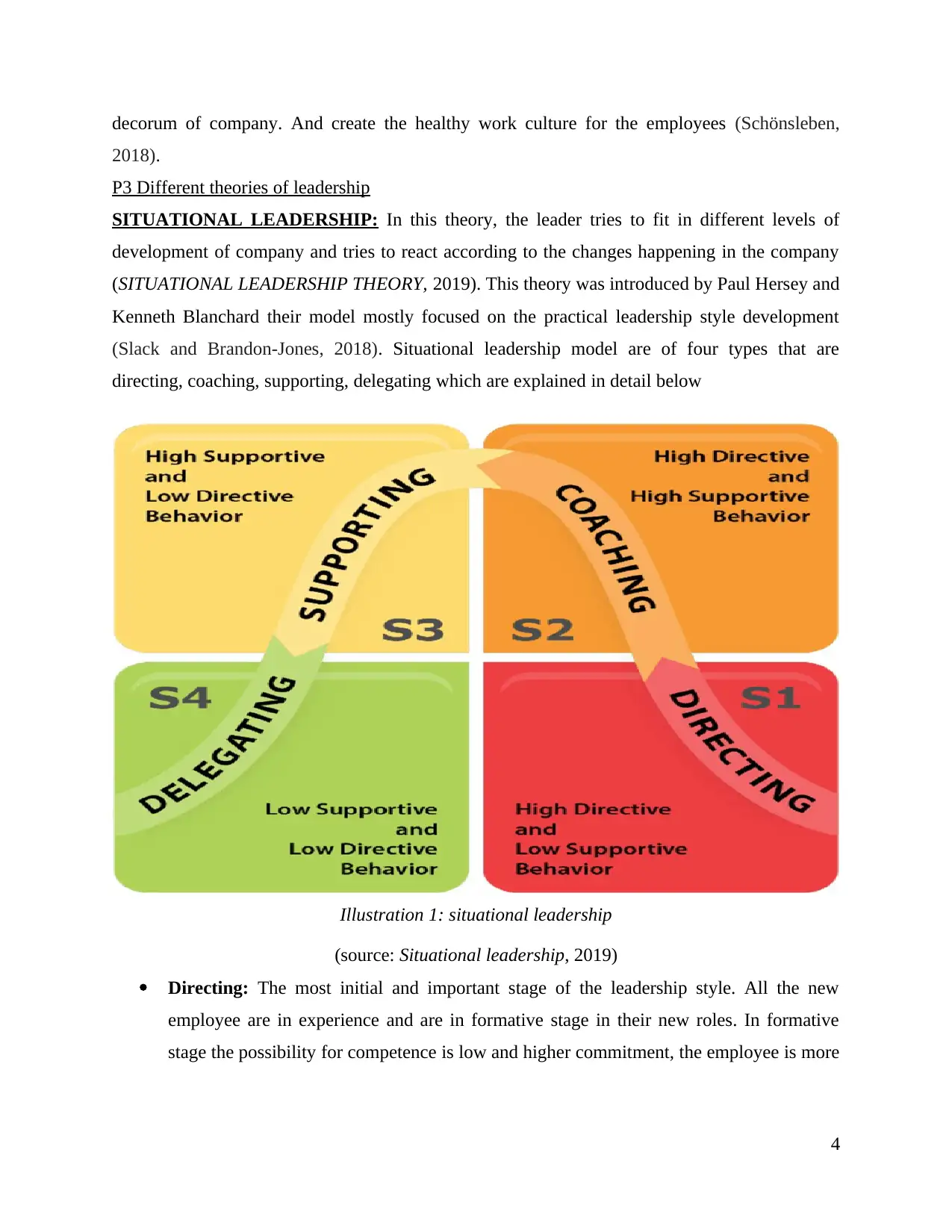
decorum of company. And create the healthy work culture for the employees (Schönsleben,
2018).
P3 Different theories of leadership
SITUATIONAL LEADERSHIP: In this theory, the leader tries to fit in different levels of
development of company and tries to react according to the changes happening in the company
(SITUATIONAL LEADERSHIP THEORY, 2019). This theory was introduced by Paul Hersey and
Kenneth Blanchard their model mostly focused on the practical leadership style development
(Slack and Brandon-Jones, 2018). Situational leadership model are of four types that are
directing, coaching, supporting, delegating which are explained in detail below
(source: Situational leadership, 2019)
Directing: The most initial and important stage of the leadership style. All the new
employee are in experience and are in formative stage in their new roles. In formative
stage the possibility for competence is low and higher commitment, the employee is more
4
Illustration 1: situational leadership
2018).
P3 Different theories of leadership
SITUATIONAL LEADERSHIP: In this theory, the leader tries to fit in different levels of
development of company and tries to react according to the changes happening in the company
(SITUATIONAL LEADERSHIP THEORY, 2019). This theory was introduced by Paul Hersey and
Kenneth Blanchard their model mostly focused on the practical leadership style development
(Slack and Brandon-Jones, 2018). Situational leadership model are of four types that are
directing, coaching, supporting, delegating which are explained in detail below
(source: Situational leadership, 2019)
Directing: The most initial and important stage of the leadership style. All the new
employee are in experience and are in formative stage in their new roles. In formative
stage the possibility for competence is low and higher commitment, the employee is more
4
Illustration 1: situational leadership
You're viewing a preview
Unlock full access by subscribing today!
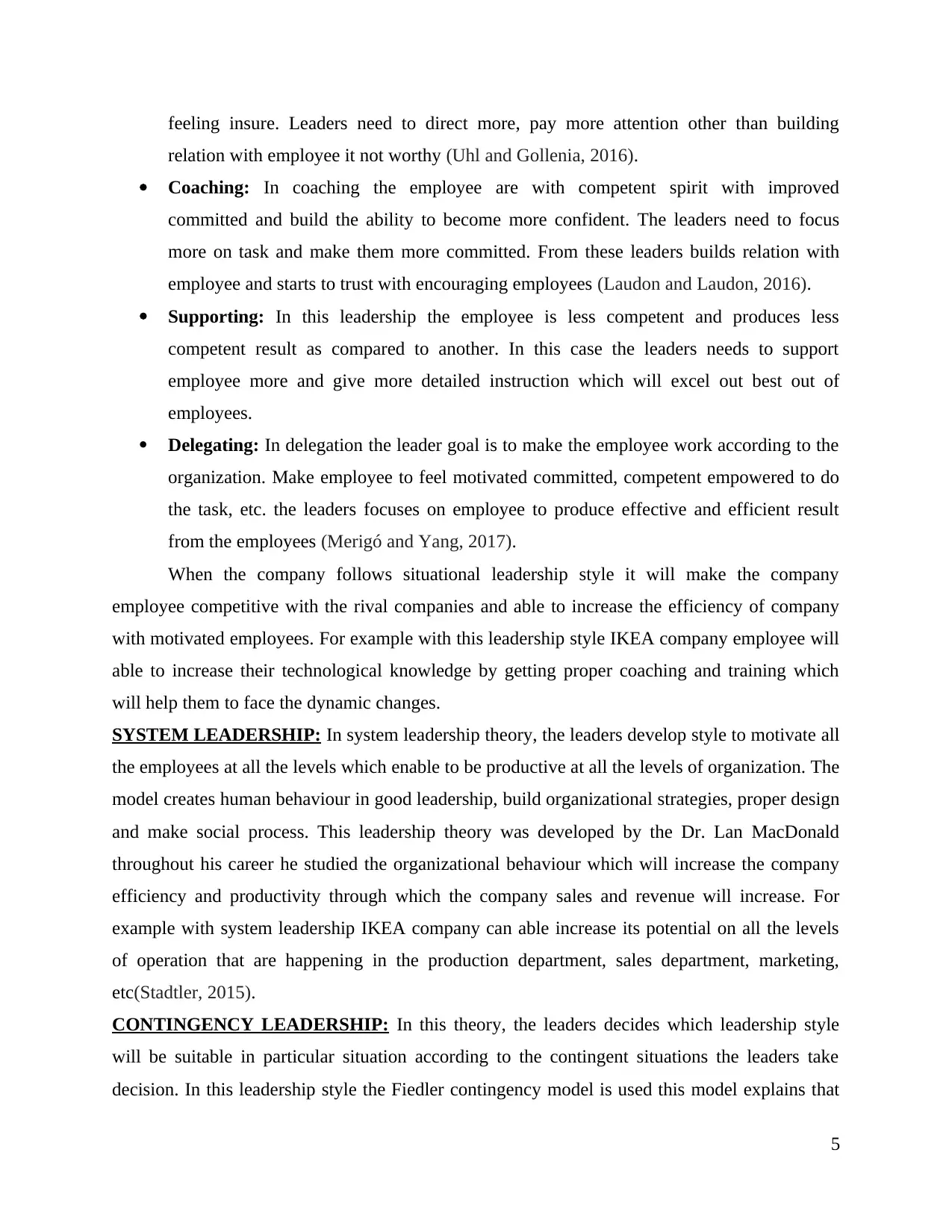
feeling insure. Leaders need to direct more, pay more attention other than building
relation with employee it not worthy (Uhl and Gollenia, 2016).
Coaching: In coaching the employee are with competent spirit with improved
committed and build the ability to become more confident. The leaders need to focus
more on task and make them more committed. From these leaders builds relation with
employee and starts to trust with encouraging employees (Laudon and Laudon, 2016).
Supporting: In this leadership the employee is less competent and produces less
competent result as compared to another. In this case the leaders needs to support
employee more and give more detailed instruction which will excel out best out of
employees.
Delegating: In delegation the leader goal is to make the employee work according to the
organization. Make employee to feel motivated committed, competent empowered to do
the task, etc. the leaders focuses on employee to produce effective and efficient result
from the employees (Merigó and Yang, 2017).
When the company follows situational leadership style it will make the company
employee competitive with the rival companies and able to increase the efficiency of company
with motivated employees. For example with this leadership style IKEA company employee will
able to increase their technological knowledge by getting proper coaching and training which
will help them to face the dynamic changes.
SYSTEM LEADERSHIP: In system leadership theory, the leaders develop style to motivate all
the employees at all the levels which enable to be productive at all the levels of organization. The
model creates human behaviour in good leadership, build organizational strategies, proper design
and make social process. This leadership theory was developed by the Dr. Lan MacDonald
throughout his career he studied the organizational behaviour which will increase the company
efficiency and productivity through which the company sales and revenue will increase. For
example with system leadership IKEA company can able increase its potential on all the levels
of operation that are happening in the production department, sales department, marketing,
etc(Stadtler, 2015).
CONTINGENCY LEADERSHIP: In this theory, the leaders decides which leadership style
will be suitable in particular situation according to the contingent situations the leaders take
decision. In this leadership style the Fiedler contingency model is used this model explains that
5
relation with employee it not worthy (Uhl and Gollenia, 2016).
Coaching: In coaching the employee are with competent spirit with improved
committed and build the ability to become more confident. The leaders need to focus
more on task and make them more committed. From these leaders builds relation with
employee and starts to trust with encouraging employees (Laudon and Laudon, 2016).
Supporting: In this leadership the employee is less competent and produces less
competent result as compared to another. In this case the leaders needs to support
employee more and give more detailed instruction which will excel out best out of
employees.
Delegating: In delegation the leader goal is to make the employee work according to the
organization. Make employee to feel motivated committed, competent empowered to do
the task, etc. the leaders focuses on employee to produce effective and efficient result
from the employees (Merigó and Yang, 2017).
When the company follows situational leadership style it will make the company
employee competitive with the rival companies and able to increase the efficiency of company
with motivated employees. For example with this leadership style IKEA company employee will
able to increase their technological knowledge by getting proper coaching and training which
will help them to face the dynamic changes.
SYSTEM LEADERSHIP: In system leadership theory, the leaders develop style to motivate all
the employees at all the levels which enable to be productive at all the levels of organization. The
model creates human behaviour in good leadership, build organizational strategies, proper design
and make social process. This leadership theory was developed by the Dr. Lan MacDonald
throughout his career he studied the organizational behaviour which will increase the company
efficiency and productivity through which the company sales and revenue will increase. For
example with system leadership IKEA company can able increase its potential on all the levels
of operation that are happening in the production department, sales department, marketing,
etc(Stadtler, 2015).
CONTINGENCY LEADERSHIP: In this theory, the leaders decides which leadership style
will be suitable in particular situation according to the contingent situations the leaders take
decision. In this leadership style the Fiedler contingency model is used this model explains that
5
Paraphrase This Document
Need a fresh take? Get an instant paraphrase of this document with our AI Paraphraser

effective leaders are assessed in the situation and the leadership style followed by the leaders.
This concept was introduced in mid 1960s by scientist Fred Fiedler studied the personal
characteristic of leaders in different situations. If IKEA will follow contingency theory then the
leaders need to take decision according to the contingent situation through this style the leaders
are able to deal with the emergency situation and able to resolve the problem with control in
contingency faced by the company (Bromiley and Rau, 2016). For example with use of
contingency situation the IKEA company will able assess the problems that happens in the
external environment like price fluctuation due to changes in the rival product.
LO 3
P4 The key approaches to operations management and the role that leaders and managers play
There are different key approaches to operation management. Leaders and managers play
different roles in operations management of Ikea:-
Lean manufacturing:- It is a method to minimize the waste in manufacturing process of Ikea
and this helps in increasing the productivity level of their business. The lean manufacturing helps
Ikea in reducing their time and operating costs. This leads to improvement in quality of the
products (Gibson and Parkman, 2018).
Role of leaders and managers in Lean manufacturing of Ikea are as follows:-
Leaders Managers
Leaders role is to introduce and
implement the lean manufacturing
method in Ikea.
Leaders of Ikea give vision and
direction to the organization in lean
manufacturing process (Heizer, Render
and Munson, 2017).
They are involved in sustaining and
improving the performance of all the
employees of Ikea by motivating them.
Leaders have a responsibility to guide
the employees in this change journey
Managers are involved in making
strategy that provide a proper plan for
its implementation in Ikea.
Managers of Ikea play role in
identification of the root cause of
problems coming in lean manufacturing
and solve it by interacting with the
employees and searching for
opportunity in improving the processes.
Build a positive relationship with
employees so that they work more
efficiently to reduce the waste in
6
This concept was introduced in mid 1960s by scientist Fred Fiedler studied the personal
characteristic of leaders in different situations. If IKEA will follow contingency theory then the
leaders need to take decision according to the contingent situation through this style the leaders
are able to deal with the emergency situation and able to resolve the problem with control in
contingency faced by the company (Bromiley and Rau, 2016). For example with use of
contingency situation the IKEA company will able assess the problems that happens in the
external environment like price fluctuation due to changes in the rival product.
LO 3
P4 The key approaches to operations management and the role that leaders and managers play
There are different key approaches to operation management. Leaders and managers play
different roles in operations management of Ikea:-
Lean manufacturing:- It is a method to minimize the waste in manufacturing process of Ikea
and this helps in increasing the productivity level of their business. The lean manufacturing helps
Ikea in reducing their time and operating costs. This leads to improvement in quality of the
products (Gibson and Parkman, 2018).
Role of leaders and managers in Lean manufacturing of Ikea are as follows:-
Leaders Managers
Leaders role is to introduce and
implement the lean manufacturing
method in Ikea.
Leaders of Ikea give vision and
direction to the organization in lean
manufacturing process (Heizer, Render
and Munson, 2017).
They are involved in sustaining and
improving the performance of all the
employees of Ikea by motivating them.
Leaders have a responsibility to guide
the employees in this change journey
Managers are involved in making
strategy that provide a proper plan for
its implementation in Ikea.
Managers of Ikea play role in
identification of the root cause of
problems coming in lean manufacturing
and solve it by interacting with the
employees and searching for
opportunity in improving the processes.
Build a positive relationship with
employees so that they work more
efficiently to reduce the waste in
6
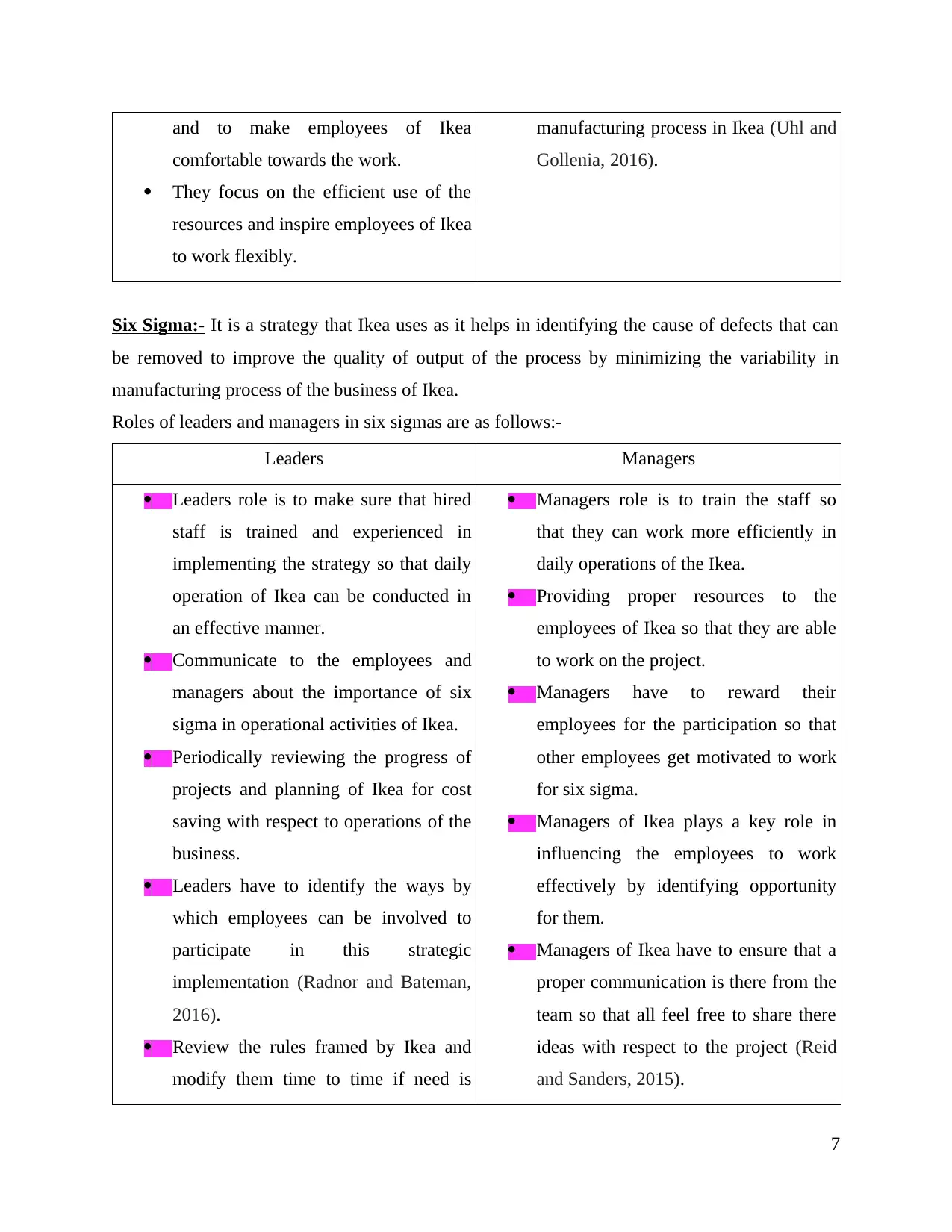
and to make employees of Ikea
comfortable towards the work.
They focus on the efficient use of the
resources and inspire employees of Ikea
to work flexibly.
manufacturing process in Ikea (Uhl and
Gollenia, 2016).
Six Sigma:- It is a strategy that Ikea uses as it helps in identifying the cause of defects that can
be removed to improve the quality of output of the process by minimizing the variability in
manufacturing process of the business of Ikea.
Roles of leaders and managers in six sigmas are as follows:-
Leaders Managers
Leaders role is to make sure that hired
staff is trained and experienced in
implementing the strategy so that daily
operation of Ikea can be conducted in
an effective manner.
Communicate to the employees and
managers about the importance of six
sigma in operational activities of Ikea.
Periodically reviewing the progress of
projects and planning of Ikea for cost
saving with respect to operations of the
business.
Leaders have to identify the ways by
which employees can be involved to
participate in this strategic
implementation (Radnor and Bateman,
2016).
Review the rules framed by Ikea and
modify them time to time if need is
Managers role is to train the staff so
that they can work more efficiently in
daily operations of the Ikea.
Providing proper resources to the
employees of Ikea so that they are able
to work on the project.
Managers have to reward their
employees for the participation so that
other employees get motivated to work
for six sigma.
Managers of Ikea plays a key role in
influencing the employees to work
effectively by identifying opportunity
for them.
Managers of Ikea have to ensure that a
proper communication is there from the
team so that all feel free to share there
ideas with respect to the project (Reid
and Sanders, 2015).
7
comfortable towards the work.
They focus on the efficient use of the
resources and inspire employees of Ikea
to work flexibly.
manufacturing process in Ikea (Uhl and
Gollenia, 2016).
Six Sigma:- It is a strategy that Ikea uses as it helps in identifying the cause of defects that can
be removed to improve the quality of output of the process by minimizing the variability in
manufacturing process of the business of Ikea.
Roles of leaders and managers in six sigmas are as follows:-
Leaders Managers
Leaders role is to make sure that hired
staff is trained and experienced in
implementing the strategy so that daily
operation of Ikea can be conducted in
an effective manner.
Communicate to the employees and
managers about the importance of six
sigma in operational activities of Ikea.
Periodically reviewing the progress of
projects and planning of Ikea for cost
saving with respect to operations of the
business.
Leaders have to identify the ways by
which employees can be involved to
participate in this strategic
implementation (Radnor and Bateman,
2016).
Review the rules framed by Ikea and
modify them time to time if need is
Managers role is to train the staff so
that they can work more efficiently in
daily operations of the Ikea.
Providing proper resources to the
employees of Ikea so that they are able
to work on the project.
Managers have to reward their
employees for the participation so that
other employees get motivated to work
for six sigma.
Managers of Ikea plays a key role in
influencing the employees to work
effectively by identifying opportunity
for them.
Managers of Ikea have to ensure that a
proper communication is there from the
team so that all feel free to share there
ideas with respect to the project (Reid
and Sanders, 2015).
7
You're viewing a preview
Unlock full access by subscribing today!
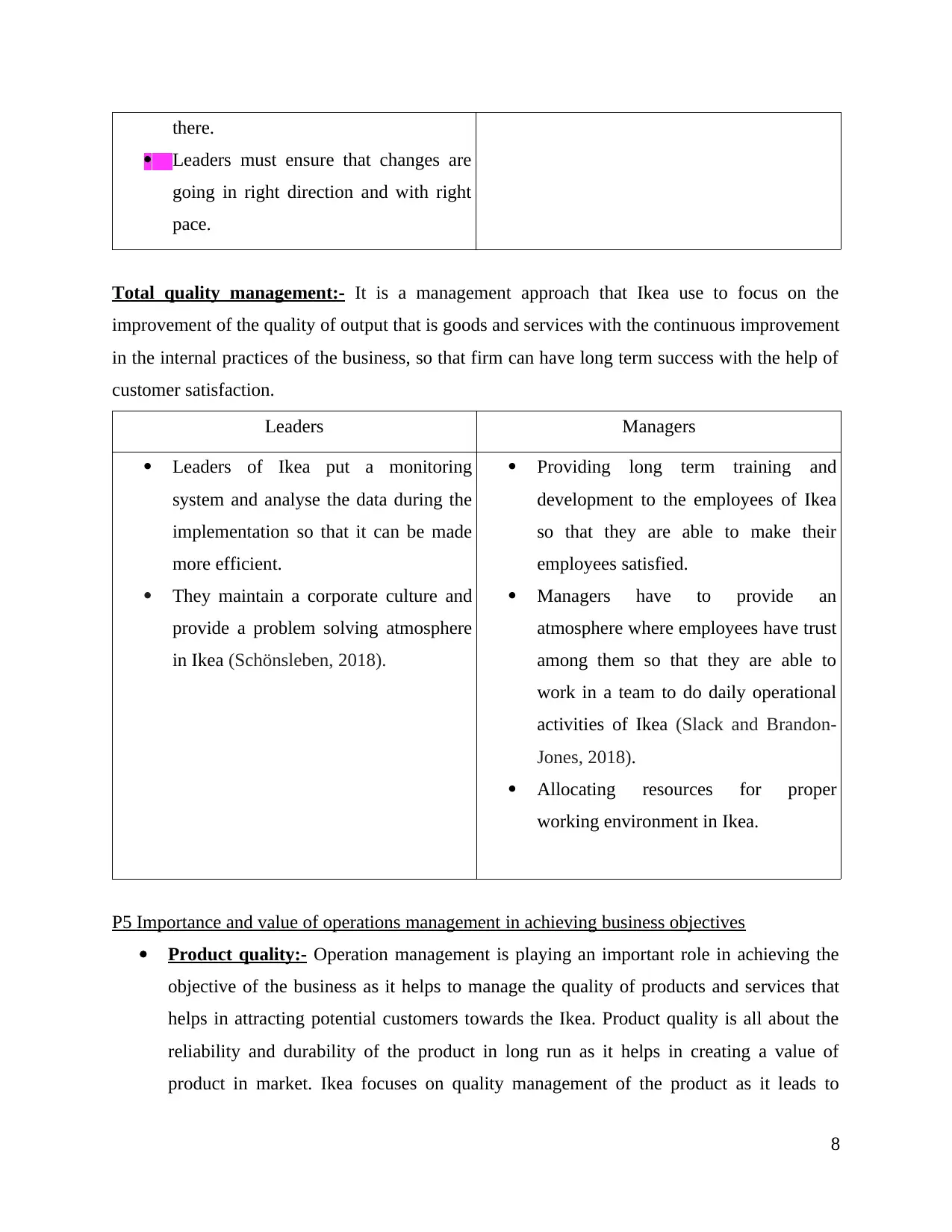
there.
Leaders must ensure that changes are
going in right direction and with right
pace.
Total quality management:- It is a management approach that Ikea use to focus on the
improvement of the quality of output that is goods and services with the continuous improvement
in the internal practices of the business, so that firm can have long term success with the help of
customer satisfaction.
Leaders Managers
Leaders of Ikea put a monitoring
system and analyse the data during the
implementation so that it can be made
more efficient.
They maintain a corporate culture and
provide a problem solving atmosphere
in Ikea (Schönsleben, 2018).
Providing long term training and
development to the employees of Ikea
so that they are able to make their
employees satisfied.
Managers have to provide an
atmosphere where employees have trust
among them so that they are able to
work in a team to do daily operational
activities of Ikea (Slack and Brandon-
Jones, 2018).
Allocating resources for proper
working environment in Ikea.
P5 Importance and value of operations management in achieving business objectives
Product quality:- Operation management is playing an important role in achieving the
objective of the business as it helps to manage the quality of products and services that
helps in attracting potential customers towards the Ikea. Product quality is all about the
reliability and durability of the product in long run as it helps in creating a value of
product in market. Ikea focuses on quality management of the product as it leads to
8
Leaders must ensure that changes are
going in right direction and with right
pace.
Total quality management:- It is a management approach that Ikea use to focus on the
improvement of the quality of output that is goods and services with the continuous improvement
in the internal practices of the business, so that firm can have long term success with the help of
customer satisfaction.
Leaders Managers
Leaders of Ikea put a monitoring
system and analyse the data during the
implementation so that it can be made
more efficient.
They maintain a corporate culture and
provide a problem solving atmosphere
in Ikea (Schönsleben, 2018).
Providing long term training and
development to the employees of Ikea
so that they are able to make their
employees satisfied.
Managers have to provide an
atmosphere where employees have trust
among them so that they are able to
work in a team to do daily operational
activities of Ikea (Slack and Brandon-
Jones, 2018).
Allocating resources for proper
working environment in Ikea.
P5 Importance and value of operations management in achieving business objectives
Product quality:- Operation management is playing an important role in achieving the
objective of the business as it helps to manage the quality of products and services that
helps in attracting potential customers towards the Ikea. Product quality is all about the
reliability and durability of the product in long run as it helps in creating a value of
product in market. Ikea focuses on quality management of the product as it leads to
8
Paraphrase This Document
Need a fresh take? Get an instant paraphrase of this document with our AI Paraphraser
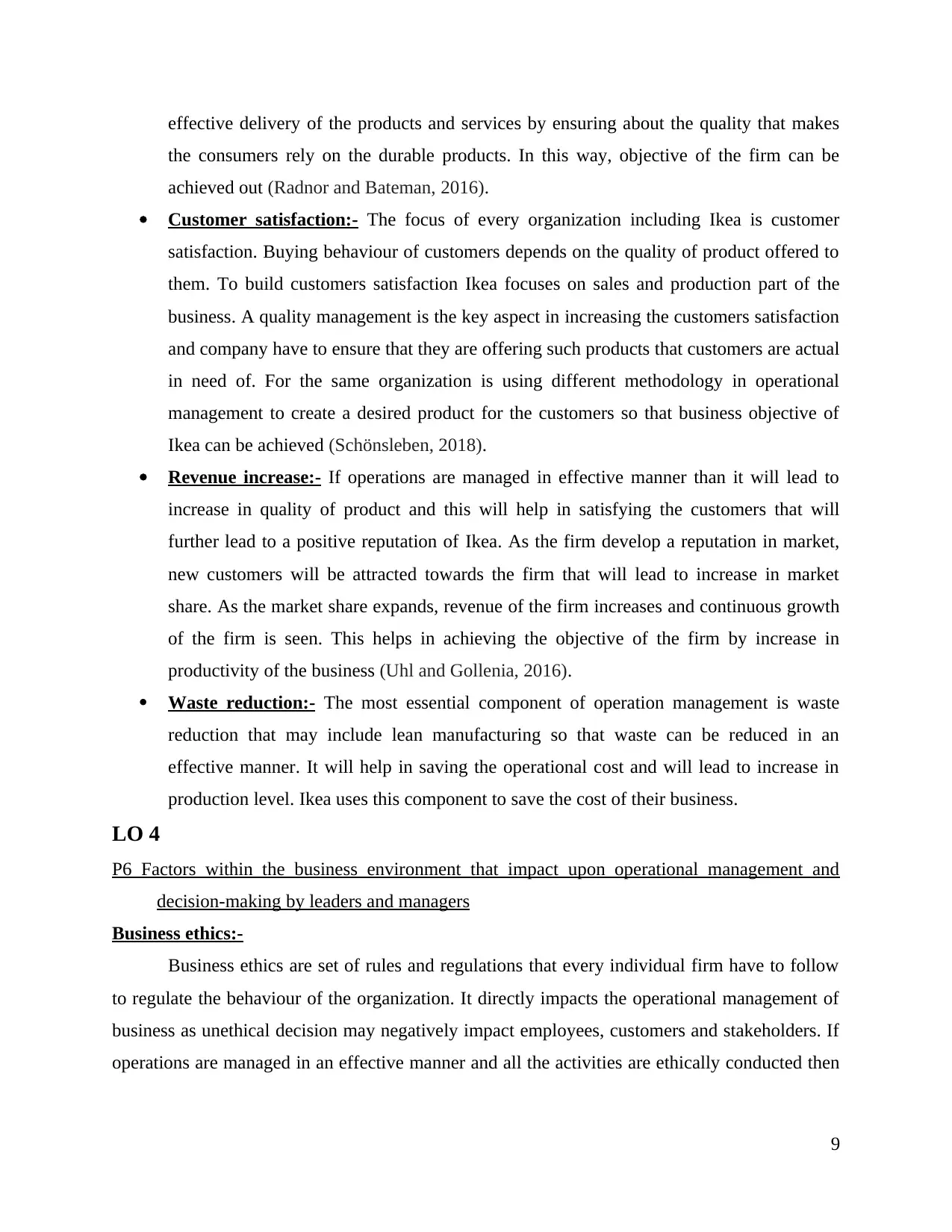
effective delivery of the products and services by ensuring about the quality that makes
the consumers rely on the durable products. In this way, objective of the firm can be
achieved out (Radnor and Bateman, 2016).
Customer satisfaction:- The focus of every organization including Ikea is customer
satisfaction. Buying behaviour of customers depends on the quality of product offered to
them. To build customers satisfaction Ikea focuses on sales and production part of the
business. A quality management is the key aspect in increasing the customers satisfaction
and company have to ensure that they are offering such products that customers are actual
in need of. For the same organization is using different methodology in operational
management to create a desired product for the customers so that business objective of
Ikea can be achieved (Schönsleben, 2018).
Revenue increase:- If operations are managed in effective manner than it will lead to
increase in quality of product and this will help in satisfying the customers that will
further lead to a positive reputation of Ikea. As the firm develop a reputation in market,
new customers will be attracted towards the firm that will lead to increase in market
share. As the market share expands, revenue of the firm increases and continuous growth
of the firm is seen. This helps in achieving the objective of the firm by increase in
productivity of the business (Uhl and Gollenia, 2016).
Waste reduction:- The most essential component of operation management is waste
reduction that may include lean manufacturing so that waste can be reduced in an
effective manner. It will help in saving the operational cost and will lead to increase in
production level. Ikea uses this component to save the cost of their business.
LO 4
P6 Factors within the business environment that impact upon operational management and
decision-making by leaders and managers
Business ethics:-
Business ethics are set of rules and regulations that every individual firm have to follow
to regulate the behaviour of the organization. It directly impacts the operational management of
business as unethical decision may negatively impact employees, customers and stakeholders. If
operations are managed in an effective manner and all the activities are ethically conducted then
9
the consumers rely on the durable products. In this way, objective of the firm can be
achieved out (Radnor and Bateman, 2016).
Customer satisfaction:- The focus of every organization including Ikea is customer
satisfaction. Buying behaviour of customers depends on the quality of product offered to
them. To build customers satisfaction Ikea focuses on sales and production part of the
business. A quality management is the key aspect in increasing the customers satisfaction
and company have to ensure that they are offering such products that customers are actual
in need of. For the same organization is using different methodology in operational
management to create a desired product for the customers so that business objective of
Ikea can be achieved (Schönsleben, 2018).
Revenue increase:- If operations are managed in effective manner than it will lead to
increase in quality of product and this will help in satisfying the customers that will
further lead to a positive reputation of Ikea. As the firm develop a reputation in market,
new customers will be attracted towards the firm that will lead to increase in market
share. As the market share expands, revenue of the firm increases and continuous growth
of the firm is seen. This helps in achieving the objective of the firm by increase in
productivity of the business (Uhl and Gollenia, 2016).
Waste reduction:- The most essential component of operation management is waste
reduction that may include lean manufacturing so that waste can be reduced in an
effective manner. It will help in saving the operational cost and will lead to increase in
production level. Ikea uses this component to save the cost of their business.
LO 4
P6 Factors within the business environment that impact upon operational management and
decision-making by leaders and managers
Business ethics:-
Business ethics are set of rules and regulations that every individual firm have to follow
to regulate the behaviour of the organization. It directly impacts the operational management of
business as unethical decision may negatively impact employees, customers and stakeholders. If
operations are managed in an effective manner and all the activities are ethically conducted then
9
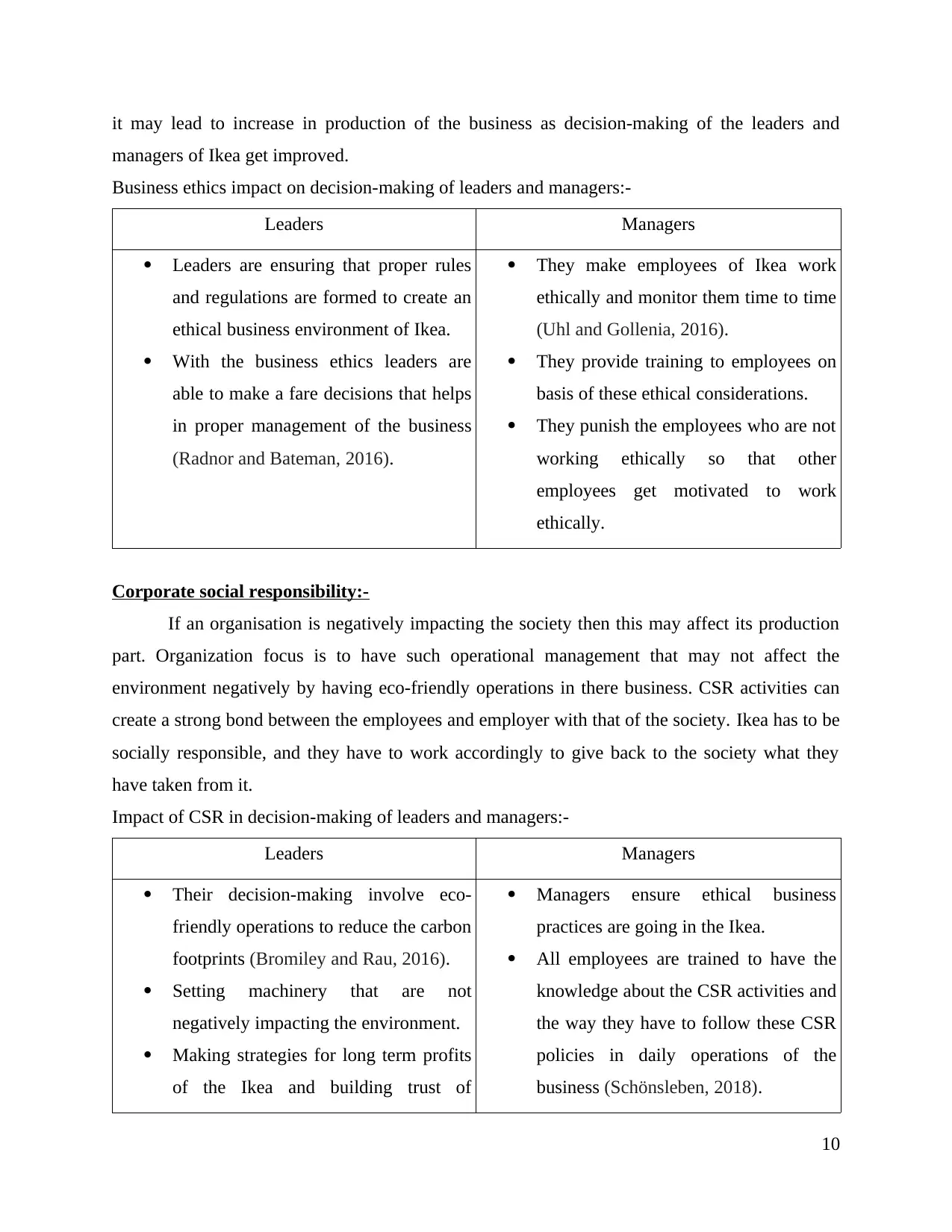
it may lead to increase in production of the business as decision-making of the leaders and
managers of Ikea get improved.
Business ethics impact on decision-making of leaders and managers:-
Leaders Managers
Leaders are ensuring that proper rules
and regulations are formed to create an
ethical business environment of Ikea.
With the business ethics leaders are
able to make a fare decisions that helps
in proper management of the business
(Radnor and Bateman, 2016).
They make employees of Ikea work
ethically and monitor them time to time
(Uhl and Gollenia, 2016).
They provide training to employees on
basis of these ethical considerations.
They punish the employees who are not
working ethically so that other
employees get motivated to work
ethically.
Corporate social responsibility:-
If an organisation is negatively impacting the society then this may affect its production
part. Organization focus is to have such operational management that may not affect the
environment negatively by having eco-friendly operations in there business. CSR activities can
create a strong bond between the employees and employer with that of the society. Ikea has to be
socially responsible, and they have to work accordingly to give back to the society what they
have taken from it.
Impact of CSR in decision-making of leaders and managers:-
Leaders Managers
Their decision-making involve eco-
friendly operations to reduce the carbon
footprints (Bromiley and Rau, 2016).
Setting machinery that are not
negatively impacting the environment.
Making strategies for long term profits
of the Ikea and building trust of
Managers ensure ethical business
practices are going in the Ikea.
All employees are trained to have the
knowledge about the CSR activities and
the way they have to follow these CSR
policies in daily operations of the
business (Schönsleben, 2018).
10
managers of Ikea get improved.
Business ethics impact on decision-making of leaders and managers:-
Leaders Managers
Leaders are ensuring that proper rules
and regulations are formed to create an
ethical business environment of Ikea.
With the business ethics leaders are
able to make a fare decisions that helps
in proper management of the business
(Radnor and Bateman, 2016).
They make employees of Ikea work
ethically and monitor them time to time
(Uhl and Gollenia, 2016).
They provide training to employees on
basis of these ethical considerations.
They punish the employees who are not
working ethically so that other
employees get motivated to work
ethically.
Corporate social responsibility:-
If an organisation is negatively impacting the society then this may affect its production
part. Organization focus is to have such operational management that may not affect the
environment negatively by having eco-friendly operations in there business. CSR activities can
create a strong bond between the employees and employer with that of the society. Ikea has to be
socially responsible, and they have to work accordingly to give back to the society what they
have taken from it.
Impact of CSR in decision-making of leaders and managers:-
Leaders Managers
Their decision-making involve eco-
friendly operations to reduce the carbon
footprints (Bromiley and Rau, 2016).
Setting machinery that are not
negatively impacting the environment.
Making strategies for long term profits
of the Ikea and building trust of
Managers ensure ethical business
practices are going in the Ikea.
All employees are trained to have the
knowledge about the CSR activities and
the way they have to follow these CSR
policies in daily operations of the
business (Schönsleben, 2018).
10
You're viewing a preview
Unlock full access by subscribing today!
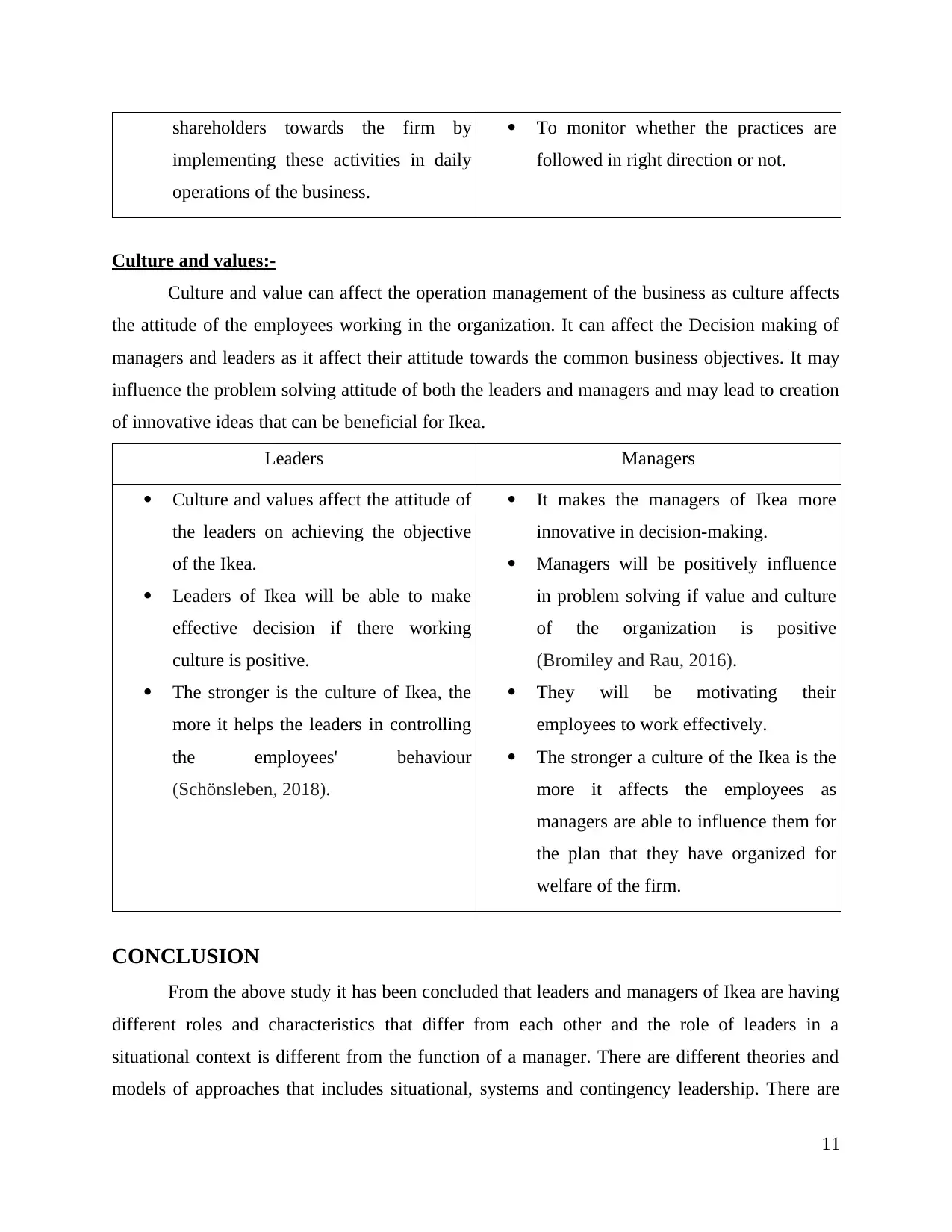
shareholders towards the firm by
implementing these activities in daily
operations of the business.
To monitor whether the practices are
followed in right direction or not.
Culture and values:-
Culture and value can affect the operation management of the business as culture affects
the attitude of the employees working in the organization. It can affect the Decision making of
managers and leaders as it affect their attitude towards the common business objectives. It may
influence the problem solving attitude of both the leaders and managers and may lead to creation
of innovative ideas that can be beneficial for Ikea.
Leaders Managers
Culture and values affect the attitude of
the leaders on achieving the objective
of the Ikea.
Leaders of Ikea will be able to make
effective decision if there working
culture is positive.
The stronger is the culture of Ikea, the
more it helps the leaders in controlling
the employees' behaviour
(Schönsleben, 2018).
It makes the managers of Ikea more
innovative in decision-making.
Managers will be positively influence
in problem solving if value and culture
of the organization is positive
(Bromiley and Rau, 2016).
They will be motivating their
employees to work effectively.
The stronger a culture of the Ikea is the
more it affects the employees as
managers are able to influence them for
the plan that they have organized for
welfare of the firm.
CONCLUSION
From the above study it has been concluded that leaders and managers of Ikea are having
different roles and characteristics that differ from each other and the role of leaders in a
situational context is different from the function of a manager. There are different theories and
models of approaches that includes situational, systems and contingency leadership. There are
11
implementing these activities in daily
operations of the business.
To monitor whether the practices are
followed in right direction or not.
Culture and values:-
Culture and value can affect the operation management of the business as culture affects
the attitude of the employees working in the organization. It can affect the Decision making of
managers and leaders as it affect their attitude towards the common business objectives. It may
influence the problem solving attitude of both the leaders and managers and may lead to creation
of innovative ideas that can be beneficial for Ikea.
Leaders Managers
Culture and values affect the attitude of
the leaders on achieving the objective
of the Ikea.
Leaders of Ikea will be able to make
effective decision if there working
culture is positive.
The stronger is the culture of Ikea, the
more it helps the leaders in controlling
the employees' behaviour
(Schönsleben, 2018).
It makes the managers of Ikea more
innovative in decision-making.
Managers will be positively influence
in problem solving if value and culture
of the organization is positive
(Bromiley and Rau, 2016).
They will be motivating their
employees to work effectively.
The stronger a culture of the Ikea is the
more it affects the employees as
managers are able to influence them for
the plan that they have organized for
welfare of the firm.
CONCLUSION
From the above study it has been concluded that leaders and managers of Ikea are having
different roles and characteristics that differ from each other and the role of leaders in a
situational context is different from the function of a manager. There are different theories and
models of approaches that includes situational, systems and contingency leadership. There are
11
Paraphrase This Document
Need a fresh take? Get an instant paraphrase of this document with our AI Paraphraser
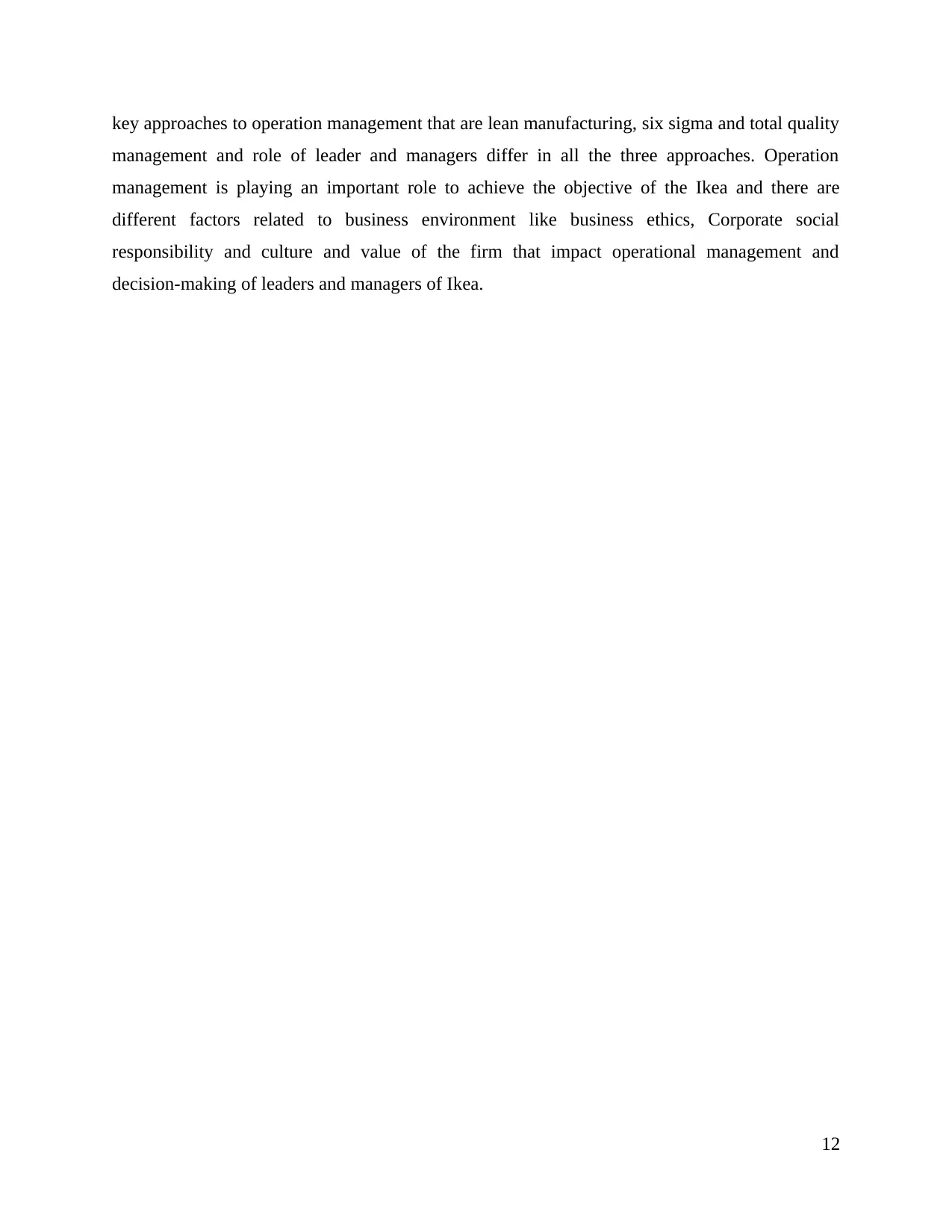
key approaches to operation management that are lean manufacturing, six sigma and total quality
management and role of leader and managers differ in all the three approaches. Operation
management is playing an important role to achieve the objective of the Ikea and there are
different factors related to business environment like business ethics, Corporate social
responsibility and culture and value of the firm that impact operational management and
decision-making of leaders and managers of Ikea.
12
management and role of leader and managers differ in all the three approaches. Operation
management is playing an important role to achieve the objective of the Ikea and there are
different factors related to business environment like business ethics, Corporate social
responsibility and culture and value of the firm that impact operational management and
decision-making of leaders and managers of Ikea.
12
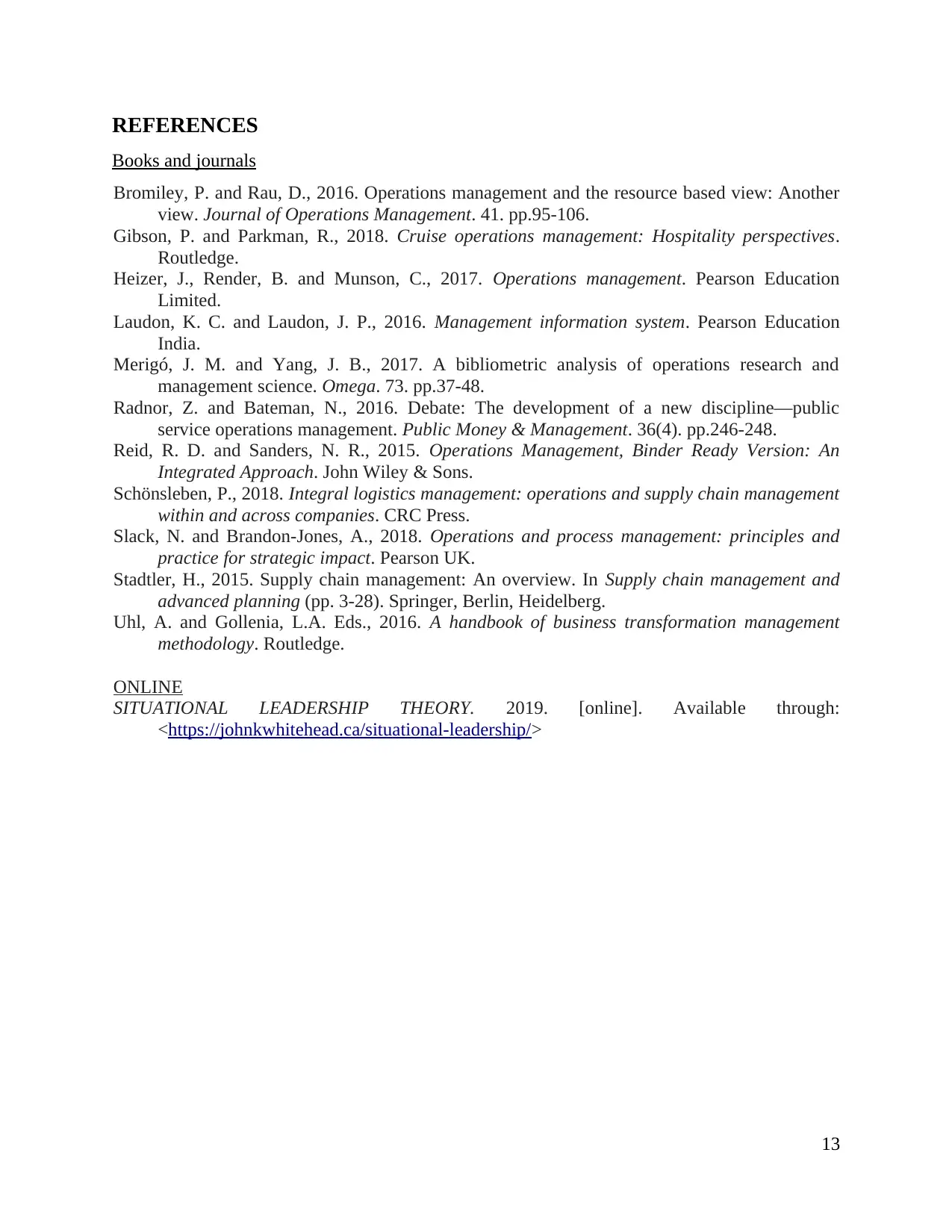
REFERENCES
Books and journals
Bromiley, P. and Rau, D., 2016. Operations management and the resource based view: Another
view. Journal of Operations Management. 41. pp.95-106.
Gibson, P. and Parkman, R., 2018. Cruise operations management: Hospitality perspectives.
Routledge.
Heizer, J., Render, B. and Munson, C., 2017. Operations management. Pearson Education
Limited.
Laudon, K. C. and Laudon, J. P., 2016. Management information system. Pearson Education
India.
Merigó, J. M. and Yang, J. B., 2017. A bibliometric analysis of operations research and
management science. Omega. 73. pp.37-48.
Radnor, Z. and Bateman, N., 2016. Debate: The development of a new discipline—public
service operations management. Public Money & Management. 36(4). pp.246-248.
Reid, R. D. and Sanders, N. R., 2015. Operations Management, Binder Ready Version: An
Integrated Approach. John Wiley & Sons.
Schönsleben, P., 2018. Integral logistics management: operations and supply chain management
within and across companies. CRC Press.
Slack, N. and Brandon-Jones, A., 2018. Operations and process management: principles and
practice for strategic impact. Pearson UK.
Stadtler, H., 2015. Supply chain management: An overview. In Supply chain management and
advanced planning (pp. 3-28). Springer, Berlin, Heidelberg.
Uhl, A. and Gollenia, L.A. Eds., 2016. A handbook of business transformation management
methodology. Routledge.
ONLINE
SITUATIONAL LEADERSHIP THEORY. 2019. [online]. Available through:
<https://johnkwhitehead.ca/situational-leadership/>
13
Books and journals
Bromiley, P. and Rau, D., 2016. Operations management and the resource based view: Another
view. Journal of Operations Management. 41. pp.95-106.
Gibson, P. and Parkman, R., 2018. Cruise operations management: Hospitality perspectives.
Routledge.
Heizer, J., Render, B. and Munson, C., 2017. Operations management. Pearson Education
Limited.
Laudon, K. C. and Laudon, J. P., 2016. Management information system. Pearson Education
India.
Merigó, J. M. and Yang, J. B., 2017. A bibliometric analysis of operations research and
management science. Omega. 73. pp.37-48.
Radnor, Z. and Bateman, N., 2016. Debate: The development of a new discipline—public
service operations management. Public Money & Management. 36(4). pp.246-248.
Reid, R. D. and Sanders, N. R., 2015. Operations Management, Binder Ready Version: An
Integrated Approach. John Wiley & Sons.
Schönsleben, P., 2018. Integral logistics management: operations and supply chain management
within and across companies. CRC Press.
Slack, N. and Brandon-Jones, A., 2018. Operations and process management: principles and
practice for strategic impact. Pearson UK.
Stadtler, H., 2015. Supply chain management: An overview. In Supply chain management and
advanced planning (pp. 3-28). Springer, Berlin, Heidelberg.
Uhl, A. and Gollenia, L.A. Eds., 2016. A handbook of business transformation management
methodology. Routledge.
ONLINE
SITUATIONAL LEADERSHIP THEORY. 2019. [online]. Available through:
<https://johnkwhitehead.ca/situational-leadership/>
13
You're viewing a preview
Unlock full access by subscribing today!
1 out of 15
Related Documents
Your All-in-One AI-Powered Toolkit for Academic Success.
+13062052269
info@desklib.com
Available 24*7 on WhatsApp / Email
![[object Object]](/_next/static/media/star-bottom.7253800d.svg)
Unlock your academic potential
© 2024 | Zucol Services PVT LTD | All rights reserved.





